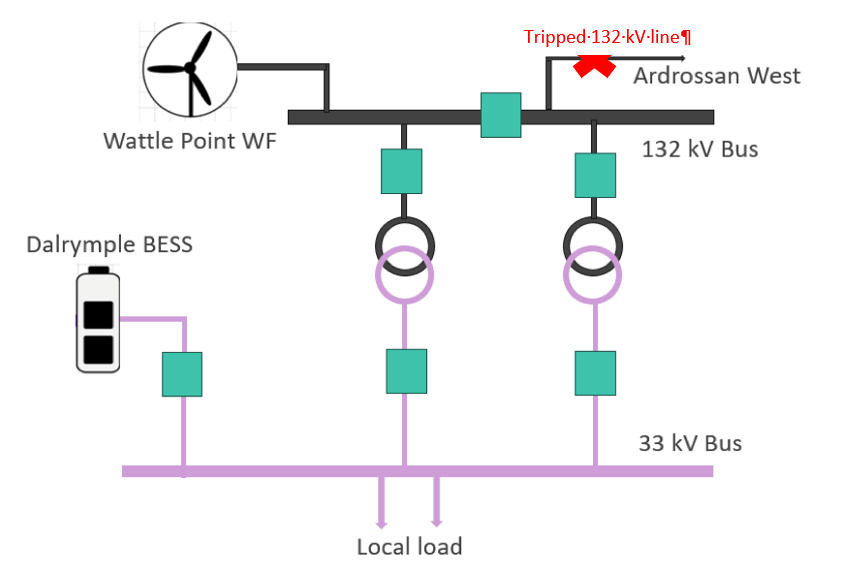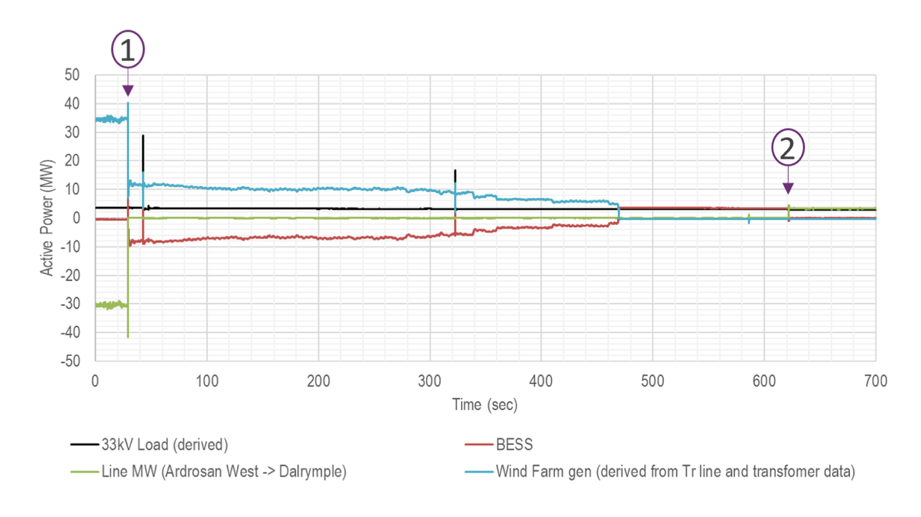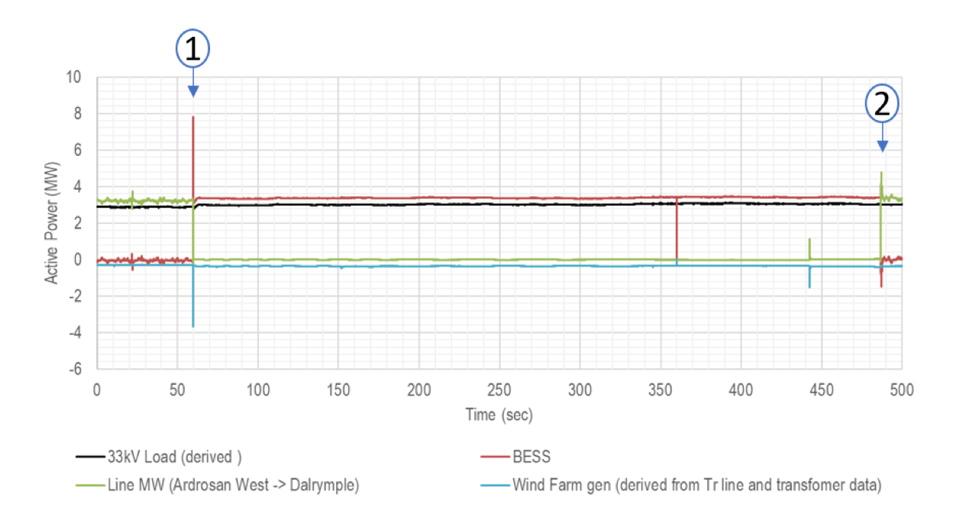Return to the GFM performance page
The Dalrymple GFM Battery Energy Storage System
The following is a summary of the analysis performed by the Australian Energy Market Operator (AEMO) during an investigation of four grid disturbance events on December 28, 2023. See the full report posted publicly by AEMO.
The Dalrymple GFM BESS is a 30 MW BESS facility connected to the 132 kV system in a remote part of the Yorke Peninsula in South Australia. The Dalrymple BESS is operated in coordination with the 91 MW Wattle Point Wind Farm also located on the Yorke Peninsula. Both resources connect to the rest of the South Australian power system through the same 132 kV Dalrymple–Ardrossan West line. As can be seen in Figure 1, if this line trips, both the Dalrymple BESS and Wattle Point Wind Farm will be isolated with a local load of 2 to 3 MW.
Figure 1: The Dalrymple GFM Battery Energy Storage System

Source: Adapted from AEMO’s Analysis and Modeling of a Grid Forming Battery Energy Storage System During a System Incident.
Summary of Events
AEMO conducted analysis on four events that occurred on December 28, 2023, that involved both the Dalrymple BESS and the Wattle Point Wind Farm. All four events were very similar with lightning strikes causing the Dalrymple – Ardrossan West 132 kV line to trip and then auto reclose, leaving both the BESS and wind resources islanded with local load. A summary of events is listed below:
- Event 1: Both the Dalrymple BESS and Wattle Point Wind were islanded with approximately 2 to 3 MW of local load at 14:52. At 15:02, after approximately 10 minutes of islanded operation, both the Dalrymple BESS and Wattle Point Wind resynchronized with the South Australia system.
- Approximately 7 minutes after Event 1, the Wattle Point Wind resource ceased generating power and had no generation during all three subsequent events.
- Event 2: The Dalrymple BESS was isolated with approximately 2 to 3 MW of local load at 15:11 and resynchronized with the South Australian system after approximately 7 minutes, at 15:18.
- Event 3: The Dalrymple BESS was isolated with approximately 2 to 3 MW of local load at 16:59 and resynchronized with the South Australian system after approximately 4 minutes, at 17:03.
- Event 4: The Dalrymple BESS was isolated with approximately 2 to 3 MW of local load at 17:32 and resynchronized with the South Australian system after approximately 3 minutes, at 17:35.
Event Analysis
For each of these four events, AEMO used high-resolution data for active and reactive power, voltage, and frequency provided by the regional transmission network service provider, ElectraNet.
Event 1
This event was unique compared with the other three December 28 events, as it was the only one in which the Wattle Point Wind resource was generating active power at the time of the event. In the subsequent events, Wattle Point Wind showed no “available” turbines and thus no active power was supplied to the system.
Figure 2 shows the measured active power of the 33 kV load, Dalrymple BESS, and the Ardrossan West – Dalrymple 132 kV transmission line. The number 1 signifies the beginning of the islanded condition, and the number 2 represents the time at which the islanded system resynchronized with the rest of the South Australian system.
Figure 2: Active Power, Event 1

Source: AEMO’s Analysis and Modeling of a Grid Forming Battery Energy Storage System During a System Incident.
Figure 2 shows some initial conditions prior to the event as well as the active power responses following the tripping of the 132 kV Ardrossan West – Dalrymple transmission line and the tripping of some feeders at Wattle Point Wind. (Some feeders at Wattle Point Wind are designed to be removed from service following the inception of islanded grid conditions in order to reduce the wind generation and create a viable island from a power balance perspective.) As can be seen from Figure 2, the Dalrymple BESS immediately absorbs the excess generation supplied by the remaining wind feeders and continues to ramp up its output to balance the slow ramping down to 0 MW generation of the wind resource, at which time the BESS is completely serving the local load in islanded conditions. This stable operation in service of load in a small islanded system shows the benefits of including grid-forming BESS technology in weak grid areas or areas with the possibility of becoming islanded.
Events 2 Through 4
These three events were very similar in that all three involved the same mechanisms for island formation as well as the in-service elements (keeping in mind that Wattle Point Wind did not generate active power during events 2 through 4). Figure 3 shows the active power of the elements involved in Event 2 with the numbers 1 and 2 indicating the beginning and end of the islanded condition respectively.
Figure 3: Active Power, Event 2

Source: AEMO’s Analysis and Modeling of a Grid Forming Battery Energy Storage System During a System Incident.
Figure 3 shows the Dalrymple BESS immediately and stably adjusting its active power generation to serve the local load following the trip of the 132 kV transmission line. The stable continuous service of load, as well as the return of the islanded system frequency and voltage to an acceptable range shows the benefits of grid-forming BESS in weak or islanded systems.
The full report provides a detailed description and discussion of all four events including plots of the measured active power, reactive power, voltage, and frequency.
Model Validation
AEMO created an electromagnetic transient (EMT) representation of the islanded power system to simulate the behavior of the modeled Dalrymple BESS, Wattle Point Wind resource, and other components after the trip of the Dalrymple – Ardrossan West transmission line. These simulated results were then compared to the high-resolution data recorded during the events.
AEMO’s full report details the case set-up for the EMT simulation, initialization, and analysis of the simulation results as compared to the measured quantities including numerous comparison plots. Key model validation findings for each event were:
- Event 1: Close alignment between the simulated results and the high-resolution data confirms the validity of the EMT models that have been developed. It should be noted that, while close alignment was observed in the steady-state frequency as well as the maximum frequency deviation, the EMT simulation did not fully capture the measured transient behavior. This observed mismatch in the transient could be due to load dynamics, which are currently unknown and thus not modeled.
- Events 2 through 4: Overall trends align reasonably well between the EMT-simulated event and the high-resolution data. Some frequency dynamics were not able to be simulated in the EMT domain potentially due to artifacts in the high-resolution data and complexities in the load model as well as the initial transients of the BESS active power response not matching closely. Additional discussion regarding discrepancies in frequency look to be applicable to all events and is located on page 27 of the full AEMO report.
Summary
These four events underscore the importance of grid-forming-enabled BESS as a method of continuing to serve load in islanded or very weak system conditions. The Dalrymple BESS showed that grid-forming control technologies, combined with sufficient stored energy, are able to successfully and smoothly continue to serve load in moderately sized islanded networks by providing power balance as well as maintaining system voltage and frequency within appropriate ranges before stably resynchronizing with the South Australian system.
